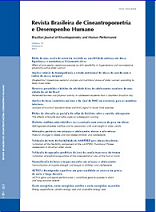The effects of bicycle seat tube angle on subsequent running.<br>
DOI:
https://doi.org/10.1590/1980-0037.2011v13n6p436Resumen
The objective of this study was to investigate the effects of two different (73° and 80°) seat tube angles (STAs) on physiological and biomechanical variables during cycling and on subsequent running performance. Six male triathletes (24.1+7.8 year; 71.3+7.6 kg; 1.76+4.8 m) completed two 20-km cycling trials (at 73° or 80°) at self-selected intensity on their own bikes using a cycle simulator and immediately transitioned to a 3-km running trial on a track at maximum pace. The trials were performed randomly on different days. The self-select intensity adopted in the first 20-km cycling trial was also used in the second cycling trial. There were no significant differences between the 73° and 80° STAs during the cycling trials. The pace during the 2nd km of the running trial was significantly lower at 73° (3.92+0.45m/s) compared with 80o (3.99+0.44m/s); however, there was no significant difference (P = 0.065) between the STAs in terms of total mean pace (4.07+0.46m/s at 73o and 4.18+0.47m/s at 80o). The stride rate (88.2+0.12 stride/min) and total mean (87.6+0.12 stride/min) during the 3rd km of the running trial were significantly lower at 73° compared with 80o (91.2+0.12 stride/min and 90.0+0.08 stride/min, respectively). Therefore, the changes in the STAs did not affect significantly the physiological and biomechanical variables during cycling neither subsequent 3-km running performance. However, the differences found in the stride rate, running pace, and tendency of better running performance (P = 0.065) suggest a small but significant effect on the running trial performed after cycling using higher STA. These aspects may have a relevant influence on the final race classification.
Descargas
Publicado
Número
Sección
Licencia

Direitos Autorais para artigos publicados nesta revista são do autor, com direitos de primeira publicação para a revista. Em virtude da aparecerem nesta revista de acesso público, os artigos são de uso gratuito, com atribuições próprias, em aplicações educacionais e não-comerciais, desde que seja dada a atribuição. Esta obra foi licenciada com uma Licença Creative Commons Atribuição 4.0 Internacional - CC BY


